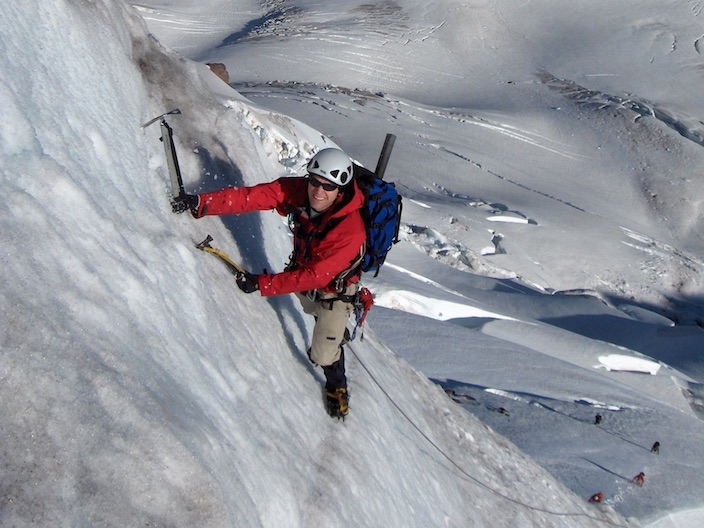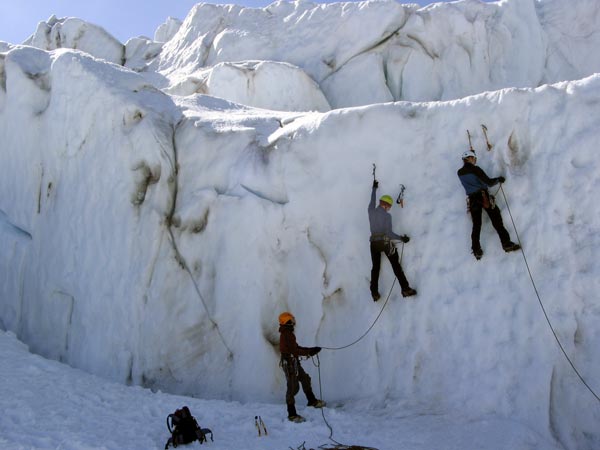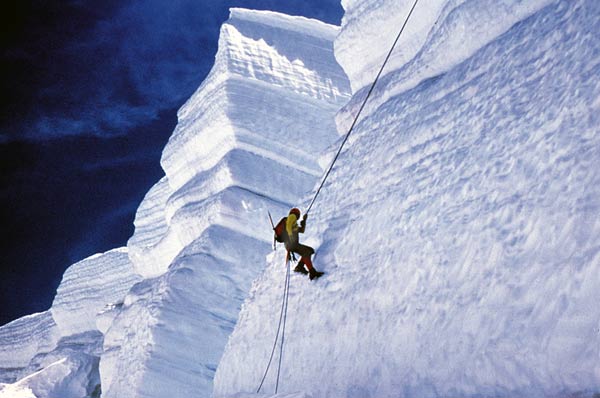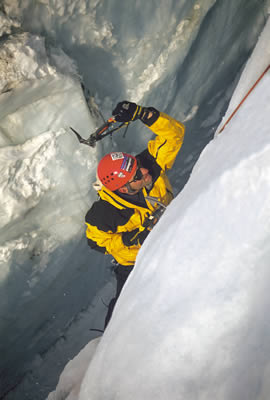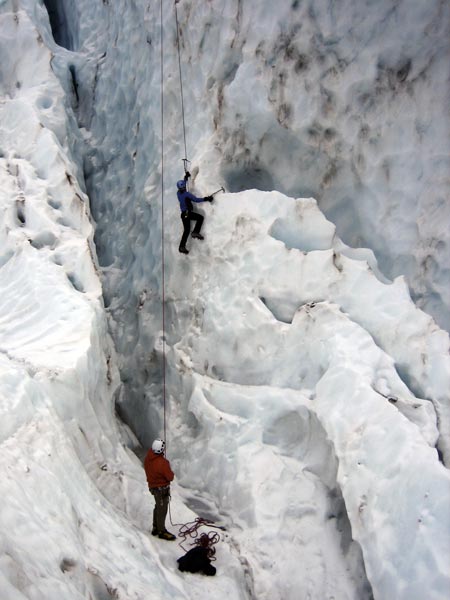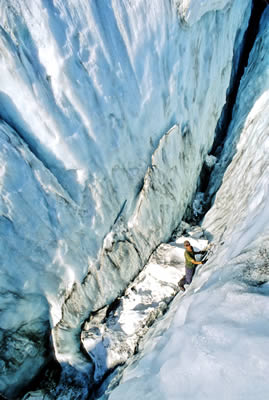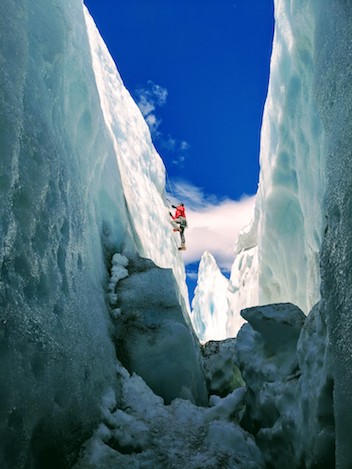Alpine Ice Climbing - Introduction Overview This is an intensive course providing comprehensive instruction in the problems met and skills required for difficult alpine ascents. The curriculum consists of fundamental snow and ice climbing skills, a detailed treatment of all intermediate and advanced techniques, and state-of-the-art climbing methods. National Accreditation Reviewers have described the program as the most comprehensive, progressive, and intense course of its type in the world, and it has been particularly noted for its emphasis on teaching climbers to lead. The entire course is spent on glaciers and a great deal of practice climbing is done each day. Instruction is given on Mt. Baker which has eighteen glaciers and routes of all technical standards.
Rappelling down a serac in one of Mt Baker's massive icefalls. Keith Gunnar
The Cascade Range is the principal training ground in America for those planning Alaskan, Andean, and Himalayan ascents. Since the ice climbing can be done in the mild and good weather months of summer, during that period one can climb on a complete range of snow and ice types, each of which require adjustment in climbing technique and protective systems. Instruction is given on the Coleman Glacier of Mt. Baker, considered the top glacial training ground in the United States.
VIDEO
Summit Climb
The course concludes with a major two-day ascent of Baker on which team members deal with logistics, challenging climbing, the operation of a wide range of protective systems, and route finding. Depending upon glacier conditions, group ability, and weather, we normally climb the North Ridge of Mt. Baker or the Roman Mustache route. Upon completion of this program participants should be technically prepared to make ascents of significantly difficult alpine and snow routes.
Alpine Ice Climbing - Introduction Curriculum Participants are instructed in a highly refined, hybrid ice climbing technique that combines the most effective aspects of American, German, and French approaches to snow and ice. Groups are very small and there is flexibility in emphasis according to individual interest & need. The curriculum includes:
During the course participants will have an opportunity to try out a variety of different ice tools.
Design concepts, performance, and selection of ice axes & technical tools
Proper choice between and application of the primary ice axe positions: piolet canne, panne, manche, poignard, ramasse, rampe, ancre, and traction
Choice between and application of American, French, and German cramponing techniques
Proper selection and placement of ice screws, snow flukes & pickets for belays and intermediate protection
The uses of mechanical belay devices in alpine climbing
Specialized designs and uses of alpine and technical tools in high angle climbing
Free climbing technique on overhanging ice
Setting up and operating hanging belays
The uses of prusiks
Crevasse rescue techniques: self-rescue, pulley systems, and pulley system combinations
The use of skiing glissades for ease and speed of descent
Glacial structure and movement: using large external landforms to predict inner glacial structures and hence the difficulties and hazards of a potential route
Evaluation of the objective hazards of avalanche, rock fall, and ice fall
Integration of specific skills with the general goals of efficient, safe, and self-dependent climbing
Leave No Trace travel, camping, and climbing
Alpine Ice Climbing - Introduction Details and Structure Max Ratio - Days 1-2, 6:1; Days 3-4, 5:1; Days 5-6, 2:1 (Climber:Guide)
Capacity - 6
Prerequisites
Good physical fitness
Ability to carry a 45 - 55 lb backpack for multiple hours
Stamina to hike for over 8 hours (including breaks, and with lesser pack weight)
Basic multi-day alpine mountaineering experience
Basic snow climbing and glacier travel skills
Program Structure
As this program progresses, the climber-to-guide ratio decreases to 2:1, allowing us to accommodate participants who progress at different rates and wish to emphasize different levels of technical difficulty. Applicants should have the basic alpine mountaineering experience taught in our Alpinism 1 Course . Tuition includes the provision of group climbing equipment. This trip is broken into three 2-day segments, each segment building upon the knowledge and skills you gain throughout the course.
SEGMENT 1: Two-Day Field Seminar Seven-mile hike to base camp adjoining the Coleman Glacier; one day spent in technical instruction & practice covering all climbing and belaying skills used on snow in its various forms; one day spent on climbing skills used on ice in its various forms.
SEGMENT 2: Two-Day Practicum Protective systems for ice climbing; leading sequence; application of ice climbing skills to difficult terrain; closely supervised technical climbing in an icefall. Glacial structures, hazard evaluation, principles of glacier travel, crevasse rescue. Route finding problems & solutions.
Big smiles as AAI Guide Jason Martin makes his way up the spectacular North Ridge of Mt. Baker. Tad Mccrea
SEGMENT 3: Ascent of a Major Route A two-day climb on which team members deal with logistics, challenging free climbing, the operation of a wide range of protective systems, & route finding. Routes are chosen for each rope team according to the proficiency demonstrated by the participants during the Seminar & Practicum. Most commonly they are Mt. Baker via the Roosevelt Headwall, North Ridge, Roman Mustache, or the 2500-foot Coleman Headwall. Easier routes are climbed when appropriate for conditions. Ascents are made with a maximum of two climbers per guide.
Navigation Programs Though this program does cover backcountry navigation, there is limited time. Some climbers choose to enhance their glacier navigation skills before or after a program by combining this class with either the three-hour Backcountry Navigation Essentials class, or the one-day Backcountry Navigation Comprehensive program.
Alpine Ice Climbing - Introduction Dates Climbing steep glacier ice on Mt. Baker's massive Coleman Glacier.
May 26 - May 31, 2024
June 09 - June 14, 2024
June 23 - June 28, 2024
July 07 - July 12, 2024
July 21 - July 26, 2024
Aug 04 - Aug 09, 2024
Aug 18 - Aug 23, 2024
Variations throughout the season... While all of these courses run during what we consider the "summer season," there is a large amount of variability in the weather and conditions that a climber could experience throughout this time. We recognize that most of our participants sign up for our programs weeks or months in advance, and although we can never be fully certain of what we'll encounter in the mountains that far out, you can click here for a description of what can typically be expected throughout the summer as well as a guide on picking the timeframe that is best for you
Alpine Ice Climbing - Introduction Testimonials
An AAI Guide takes a moment to strike a pose while demonstrating
ice climbing techniques. Doug Foust
"My guide was hands-down the best guide I have ever encountered.
He quickly ascertained our experience level, interests, and
expectations for the course, then catered to those, ensuring that
we focused on those skills we needed most."Mary Ellen Potter, Bellevue, WA
"All of the guides were positive and patient, and fostered a
'can do' learning environment. In this environment, my confidence
and technique really improved."Carol Masheter, Salt Lake City, UT
"Our guides were totally professional, totally patient, and very
well versed in all intricacies of safe travel in the
mountains."Thomas Davis, Carmel, IN
"My guide exceeded my expectations. He quickly assessed my
skills and we focused on reviewing and improving them. With his
guidance and suggestions, I showed a lot of improvement in a couple
of days, culminating in a great day on the North Ridge of Mt.
Baker."
Alpine Ice Climbing - Introduction Related Courses
Program Finder
By Location
United States - Alaska
United States - Washington
United States - California
United States - Nevada
United States - Colorado
United States - Utah
Canada - British Columbia
South America - Argentina
South America - Bolivia
South America - Ecuador
South America - Patagonia
South America - Peru
Europe - Alps and Caucasus
Asia - Nepal and Tibet
Asia - Laos, Thailand, & Vietnam
Asia - China
Asia - Japan
Africa - Tanzania
Pacific and Antarctica
By Program Type
Instructional Courses
Group Summit Climbs
Expeditions
Skills Expeditions
Private Guided Programs
Treks, Tours, & Backpacking
Corporate Outings & Services
Government & Military
By Activity
Rock Climbing
Ice Climbing
Alpine Climbing
High-Altitude Climbing
Trekking and Backpacking
Skiing & Snowboarding
Guide Training & Rescue
Avalanche Training
Departure Month
Difficulty Level
Beginner
Moderate
Intermediate
Advanced
Very Advanced
x
